Heroin is part of a class of drugs known as opiates — it is a derivative of the opium poppy plant, which historically plays a part in the production of morphine. Synthetic versions of the poppy’s active chemical are used to create opioid medications like oxycodone, fentanyl and codeine. As a group, opiates and opioids are known for their painkilling properties and for producing a euphoric, numb and pleasantly drowsy effect that is highly addictive.
Even though the dangers of heroin and similar drugs are well known and often portrayed in popular media, hundreds of thousands of Americans regularly use the drug each year, many of whom classify as having a heroin use disorder or addiction. The National Survey on Drug Use and Health puts the total number of American heroin users at nearly 500 million in 2017 and notes that these numbers have increased slightly from heroin usage rates between 2002 and 2015. Experts also agree that there is a link between the increase in prescription opioid abuse and heroin abuse. The Substance Abuse and Mental Health Services Administration notes that many young people who report using heroin also report prior recreational use of opioid medications, and the National Institute on Drug Abuse reports that up to 80% of current heroin users have also used opioids.
